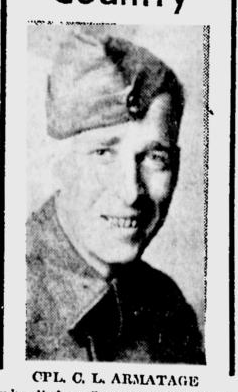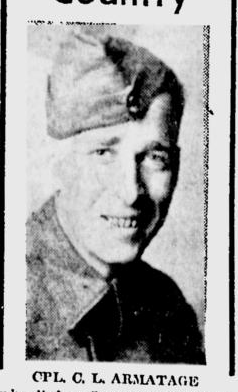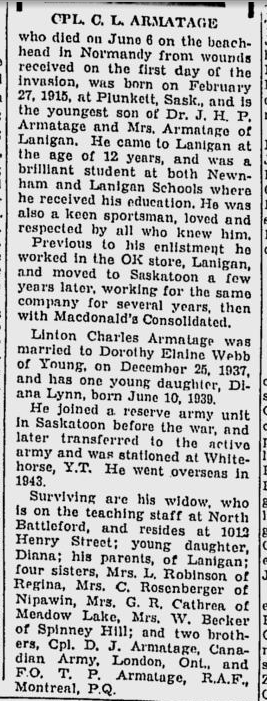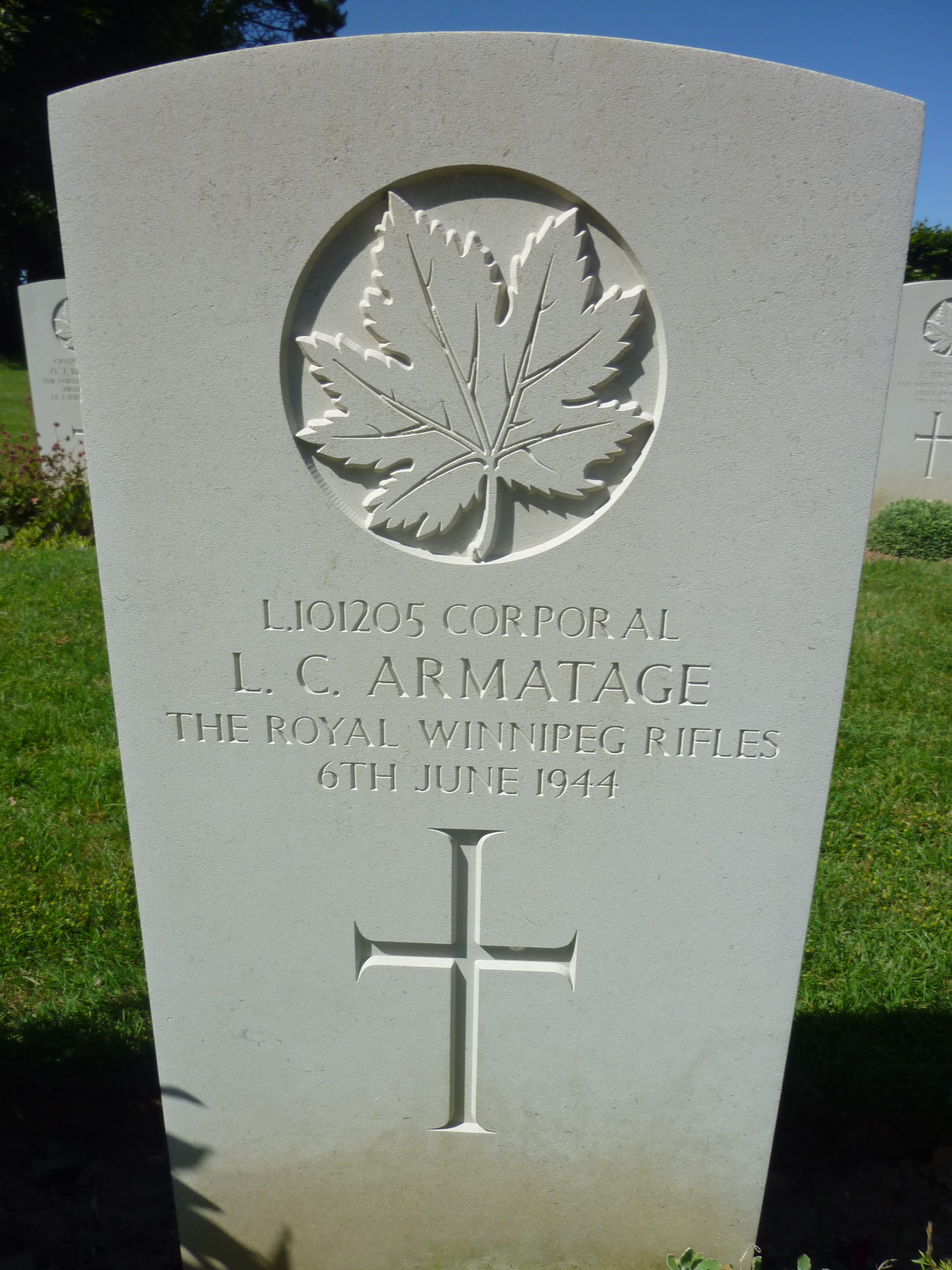The family, members of the United Church, lived for a time in Minneapolis, Minnesota, and by 1905 they were homesteading in the Attica, Saskatchewan area. They moved to and were living in the Humbolt area by 1911 and later moved to the Eltham district south of Plunkett where Linton attended school in Eltham and Lanigan.*1
Linton's siblings included Donald Jones Armatage who lived in Listowel, Ontario and was later to become part of (CASF), Trenholm Porter Armatage who became a F/O in the RCAF, Marguerite Robinson of Regina, Saskatchewan, Doris Rosenberger of Nipawin, Saskatchewan, Marian Pearl Becker of Spinney Hill, Saskatchewan and Lillian Wall of Meadow Lake, Saskatchewan, to where their parents later moved.*3
Linton was a good student, graduating with a senior matriculation and worked for several years in the OK store in Lanigan before going to Saskatoon to work for the same company.*4
Linton also worked as a shipper in the wholesale and retail grocery company, Macdonald's Consolidated, in Saskatoon for eight years, a job to which he wanted to return after the war.
He married Dorothy Elaine Webb of Young, Saskatchewan*4 December 25, 1937. Their only child, daughter Diana Lynn, was born June 10, 1939.*3
Linton served in the second battalion of the S.L.I. (MG) from 10 July 1940 to 8 July 1942. During that period 1 May 1941 he was promoted to corporal.
At the time of Linton’s enlistment in Saskatoon 8 July 1942, he was taken on strength at #12 District Depot (CASA) in Regina as a private. His family had a young British evacuee, Mary Lawson, who had been living with them since 4 January 1941. His parents were living in Lanigan where his father was the manager of the Saskatchewan Liquor store.*3
Linton stood 5 ft. 9¼ inches tall and weighed 154 pounds. He had a fair complexion, hazel eyes, brown hair and was considered to have good development. On each of Linton’s medicals, he was listed as A1, even after arches on both feet were strained in a 1938 crushing accident that forced him to remain in bed for four weeks.*3
21 July 1942 Linton was promoted to Acting Corporal without pay with #12 District Depot in Regina. He was posted to H.W.E. of #12 District Depot CAA and promoted to acting corporal with pay 25 July. By 28 July, now Private Armatage was transferred to #9 Platoon of the Aerodrome Defence at Dundurn, Saskatchewan as part of the 9th ADP.
Linton was promoted 1 August to acting L/Sgt. and had a new rate of pay of $1.90/day. By 10 August he had qualified on (wheeled) class IC111 with the 9th ADP and twelve days later he had qualified for tracked class of IC111. Still part of the 9th ADP, he was sent to Patricia Bay, B. C. and was attached to the First Battalion of the Edmonton Fusiliers 10 October.
Leaving Vancouver Island, Linton was stationed in White Horse 14 November and was put on the payroll of the 27th Regiment of the RCA. In the spring, he was granted a fourteen-day furlough plus four days traveling time. He was also entitled to draw a ration allowance for that period. He returned to the north 9 June 1943.
Back in Pat Bay, Linton was attached to the First Battalion St. John Fusiliers for A/P and pay 26 June 1943. Effective 16 July, he was attached to the First Battalion of The Brockville Rifles for A/P and pay as a L/Sgt. 1 August 1943, Linton was attached to the Third Battalion Regina Rifles from which he received his rations and quarters in Victoria 6 August. 9 August he reverted to substantive corporal and his rate of pay dropped to $1.70/day.*3
He was taken on strength at #121 CA (B) IC for A/P with the Third Battalion of the Regina Rifles 9 August and 10 August Linton was in the #1 Transit Camp in Maple Creek. 4 September after leaving the Maple Creek camp, he was attached to #1 Transit Camp at Windsor, N. S. 7 September his unit was in preparation for transferring overseas.
Linton embarked 14 September as part of 2 CIRU. After disembarking 19 September, little time was allowed for rest as Linton reported to duty the following day and by 29 October he was attached to his final regiment, The First Battalion of The Royal Winnipeg Rifles. (According to his wife he was in #13 Company of the RWR.) 15 January 1944, he was awarded the Canadian Volunteer Service Medal and Clasp. *3
While Linton was in England, his wife moved from Sutherland, Saskatchewan to North Battleford.*3
The war diary of The Royal Winnipeg Rifles gives a good account of the days leading up to the planned invasion of Normandy.*2
On Thursday, June 1 1944 at Hiltonbury Camp, the Royal Winnipeg Rifles Battalion was divided into two major craft loads, 2 assault companies in Camp C7 and 2 reinforcement companies in C8, readying for the D-day assault on Normandy. They were joined with detachments of other arms and services that made up the assault loads of company groups. In the marshaling camp, the static staff took care of daily administration. Entertainment was provided by auxiliary services and American special services. Daily PT parades kept the men busy and fit while the camp was sealed to avoid briefed information being leaked. D Company's vehicles were being sent to marshaling camps in the Gosport area. The command group remained in Camp C7.
Friday, June 2 - A and C Companies' re-enforcements were given 24-hour ration packs, emergency chocolate and vomit bags to be used if needed when on the small assault craft, water sterilizing pills and the necessary equipment for their self-containment for a 48-hour period.
In the afternoon two company groups of the Winnipeg Rifes and a re-enforcement company group of the Regina Rifles Regiment moved to the Old Docks at Southampton to board the "Llangby Castle", a boat with which they were familiar having been on board previously and were welcomed again. The food was found to be the best they had eaten since leaving Canada. They sailed in the evening and anchored in the Solent until "J" Force sailed for France.
Vehicles were loaded on LST's (Landing Ship Tanks) that carried a large number of tanks, vehicles and other cargo directly to the beaches and without which there would have been no successful invasion. LCT's (Landing Craft Tanks) were used to transport 5 to 6 tanks to the beaches and were responsible for unloading the DD (Double duplex) tanks. Some were to launch rockets on German positions on D-day. The assault men remained in Camp C7.
Saturday, June 3, the men in the re-enforcement companies and the rear battalion headquarters people familiarized themselves with boat stations, carried on with PT, weapon inspections; their entertainment was a movie. B and D Companies were equipped with emergency rations and left Camp C7 for Southampton, boarding the Laird Islet and Canterbury, anchoring in the Solent.*2
Tuesday, June 6 - 4:00. The day was cloudy and cool with strong NW winds and heavy seas. Breakfast consisted of tea and a cold snack.
5:15 - LCA's (Landing Craft Assaults) were manned with the first wave of men to go ashore in Normandy and lowered from LSH's 10 miles from the coast.
6:55 - The LCH's had been standing off the coast for almost 3 hours as the Royal Navy and artillary bombarded the coast, SP (Self Projected) guns were afloat, shelling short of their targets due to the weather, killing no Germans and destroying no guns. (From the Landing Craft Headquarters craft plans were made and revised. These boats assigned to the different beaches had up to 2300 messages in one day, clearing bottlenecks such as obstacles on beaches and enemy fire, repositioning men and guns to support troops, planned alternate strategies, advising troops and the admiralty.)
The air bombardment failed to materialize. The DD's (Duplex drive) tanks and AVRE's (modified armoured tank-based vehicles operated by the Engineers) were late getting in place.
At 7:49 C Company of the First Canadian Scottish Regiment (under Major Desmond Crofton) under the Winnipeg Rifles' command, landed at the junction of MIKE and LOVE for the assault on the beach defence left of MIKE GREEN and B Company (under Captain P. E. Gower) with u/c No. 15 Platoon and two sections of No. 6 Forward Company of the Royal Canadian Engineers on "Mike Red"--all within 7 minutes of one another.
Men were forced to wade ashore in chest-deep water facing machine gun and mortar fire on the western edges of Courseulles-sur-Mer and did so without hesitation. Many died in the water trying to get to the heavily fortified German positions. Once their tanks were ashore they were able to take out the guns, clear the harbor and make their way through minefields. After surrounding the enemy occupying an island in the Seulles River, the Germans surrendered.*2
B Company and the Royal Canadian Engineers, 6 Field Company who were in early to clear debris from the beaches and clear mind fields lost 3/4 of their men, the heaviest casualties of the landing, with only 26 men left in B Company.*2
Corporal Linton Armatage died on the beach that 6 June 1944 day. He was buried in Monsieur Guddeville’s orchard at Graye-sur-Mer, as reported by CF 7 Beach group. Sheet 7E/5 960848. Graye-sur-Mer is a village on the coast 11 miles NW of Caen*3 and close to Courseulles-sur-Mer and "Juno Beach".
His body was later respectfully removed and placed in the Beny-sur-Mer Cemetery, the site marked by a temporary cross.*3 Since that time a more permanent marker was placed at his grave and for the 70th anniversary of the D-day landing, all tombstones in the cemetery had been replaced.
D-day saw 14,000 Canadians land in Normandy, 1074 were casualties and of those, 359 were killed, among them Corporal Linton Charles Armatage. He had served in Canada from 8 July 1942 to 14 September 1943 and in the UK from 15 September 1944 to 5 June 1944.*3
For his service to his country, Cpl. Linton Charles Armatage was awarded the 1939-45 Star, the France-German Star, and the Defence War Medal.*3
Dorothy was living in North Battleford when she received a $47.19 cheque for War Service Gratuity 26 September 1945. Linton had been supporting his wife and daughter as well as his mother. His mother wanted her daughter-in-law to receive whatever compensation was due.*3 Linton had taken out a life insurance policy with the Dominion Life Assurance Company for $1000 to be paid to his wife in the event of his death. Dorothy also received Linton’s three War Savings certificates valued at $15. Linton's leather writing case and two photographs were returned to his widow.
The Province of Saskatchewan honored Corporal Linton Charles Armatage when they granted a geo-memorial, Armatage Bay, named after the native son lost in war. The bay is found at 57.6833 degrees N/106.3167 degrees west.*1
A memorial may also be found on the Saskatchewan Virtual War Memorial internet site.
http://svwm.ca/casualty-display/?ID=A000006519
*1 Age Shall Not Weary Them.
*2 1-7 June 1944 War Diary of the Royal Winnipeg Rifles Courtesy of the Royal Winnipeg Rifles Museum
*3 Library and Archives Canada - RG 24 Vol. 25341 P.221 Armatage, Linton Charles L101205
*4 The attached obituary.
The family, members of the United Church, lived for a time in Minneapolis, Minnesota, and by 1905 they were homesteading in the Attica, Saskatchewan area. They moved to and were living in the Humbolt area by 1911 and later moved to the Eltham district south of Plunkett where Linton attended school in Eltham and Lanigan.*1
Linton's siblings included Donald Jones Armatage who lived in Listowel, Ontario and was later to become part of (CASF), Trenholm Porter Armatage who became a F/O in the RCAF, Marguerite Robinson of Regina, Saskatchewan, Doris Rosenberger of Nipawin, Saskatchewan, Marian Pearl Becker of Spinney Hill, Saskatchewan and Lillian Wall of Meadow Lake, Saskatchewan, to where their parents later moved.*3
Linton was a good student, graduating with a senior matriculation and worked for several years in the OK store in Lanigan before going to Saskatoon to work for the same company.*4
Linton also worked as a shipper in the wholesale and retail grocery company, Macdonald's Consolidated, in Saskatoon for eight years, a job to which he wanted to return after the war.
He married Dorothy Elaine Webb of Young, Saskatchewan*4 December 25, 1937. Their only child, daughter Diana Lynn, was born June 10, 1939.*3
Linton served in the second battalion of the S.L.I. (MG) from 10 July 1940 to 8 July 1942. During that period 1 May 1941 he was promoted to corporal.
At the time of Linton’s enlistment in Saskatoon 8 July 1942, he was taken on strength at #12 District Depot (CASA) in Regina as a private. His family had a young British evacuee, Mary Lawson, who had been living with them since 4 January 1941. His parents were living in Lanigan where his father was the manager of the Saskatchewan Liquor store.*3
Linton stood 5 ft. 9¼ inches tall and weighed 154 pounds. He had a fair complexion, hazel eyes, brown hair and was considered to have good development. On each of Linton’s medicals, he was listed as A1, even after arches on both feet were strained in a 1938 crushing accident that forced him to remain in bed for four weeks.*3
21 July 1942 Linton was promoted to Acting Corporal without pay with #12 District Depot in Regina. He was posted to H.W.E. of #12 District Depot CAA and promoted to acting corporal with pay 25 July. By 28 July, now Private Armatage was transferred to #9 Platoon of the Aerodrome Defence at Dundurn, Saskatchewan as part of the 9th ADP.
Linton was promoted 1 August to acting L/Sgt. and had a new rate of pay of $1.90/day. By 10 August he had qualified on (wheeled) class IC111 with the 9th ADP and twelve days later he had qualified for tracked class of IC111. Still part of the 9th ADP, he was sent to Patricia Bay, B. C. and was attached to the First Battalion of the Edmonton Fusiliers 10 October.
Leaving Vancouver Island, Linton was stationed in White Horse 14 November and was put on the payroll of the 27th Regiment of the RCA. In the spring, he was granted a fourteen-day furlough plus four days traveling time. He was also entitled to draw a ration allowance for that period. He returned to the north 9 June 1943.
Back in Pat Bay, Linton was attached to the First Battalion St. John Fusiliers for A/P and pay 26 June 1943. Effective 16 July, he was attached to the First Battalion of The Brockville Rifles for A/P and pay as a L/Sgt. 1 August 1943, Linton was attached to the Third Battalion Regina Rifles from which he received his rations and quarters in Victoria 6 August. 9 August he reverted to substantive corporal and his rate of pay dropped to $1.70/day.*3
He was taken on strength at #121 CA (B) IC for A/P with the Third Battalion of the Regina Rifles 9 August and 10 August Linton was in the #1 Transit Camp in Maple Creek. 4 September after leaving the Maple Creek camp, he was attached to #1 Transit Camp at Windsor, N. S. 7 September his unit was in preparation for transferring overseas.
Linton embarked 14 September as part of 2 CIRU. After disembarking 19 September, little time was allowed for rest as Linton reported to duty the following day and by 29 October he was attached to his final regiment, The First Battalion of The Royal Winnipeg Rifles. (According to his wife he was in #13 Company of the RWR.) 15 January 1944, he was awarded the Canadian Volunteer Service Medal and Clasp. *3
While Linton was in England, his wife moved from Sutherland, Saskatchewan to North Battleford.*3
The war diary of The Royal Winnipeg Rifles gives a good account of the days leading up to the planned invasion of Normandy.*2
On Thursday, June 1 1944 at Hiltonbury Camp, the Royal Winnipeg Rifles Battalion was divided into two major craft loads, 2 assault companies in Camp C7 and 2 reinforcement companies in C8, readying for the D-day assault on Normandy. They were joined with detachments of other arms and services that made up the assault loads of company groups. In the marshaling camp, the static staff took care of daily administration. Entertainment was provided by auxiliary services and American special services. Daily PT parades kept the men busy and fit while the camp was sealed to avoid briefed information being leaked. D Company's vehicles were being sent to marshaling camps in the Gosport area. The command group remained in Camp C7.
Friday, June 2 - A and C Companies' re-enforcements were given 24-hour ration packs, emergency chocolate and vomit bags to be used if needed when on the small assault craft, water sterilizing pills and the necessary equipment for their self-containment for a 48-hour period.
In the afternoon two company groups of the Winnipeg Rifes and a re-enforcement company group of the Regina Rifles Regiment moved to the Old Docks at Southampton to board the "Llangby Castle", a boat with which they were familiar having been on board previously and were welcomed again. The food was found to be the best they had eaten since leaving Canada. They sailed in the evening and anchored in the Solent until "J" Force sailed for France.
Vehicles were loaded on LST's (Landing Ship Tanks) that carried a large number of tanks, vehicles and other cargo directly to the beaches and without which there would have been no successful invasion. LCT's (Landing Craft Tanks) were used to transport 5 to 6 tanks to the beaches and were responsible for unloading the DD (Double duplex) tanks. Some were to launch rockets on German positions on D-day. The assault men remained in Camp C7.
Saturday, June 3, the men in the re-enforcement companies and the rear battalion headquarters people familiarized themselves with boat stations, carried on with PT, weapon inspections; their entertainment was a movie. B and D Companies were equipped with emergency rations and left Camp C7 for Southampton, boarding the Laird Islet and Canterbury, anchoring in the Solent.*2
Tuesday, June 6 - 4:00. The day was cloudy and cool with strong NW winds and heavy seas. Breakfast consisted of tea and a cold snack.
5:15 - LCA's (Landing Craft Assaults) were manned with the first wave of men to go ashore in Normandy and lowered from LSH's 10 miles from the coast.
6:55 - The LCH's had been standing off the coast for almost 3 hours as the Royal Navy and artillary bombarded the coast, SP (Self Projected) guns were afloat, shelling short of their targets due to the weather, killing no Germans and destroying no guns. (From the Landing Craft Headquarters craft plans were made and revised. These boats assigned to the different beaches had up to 2300 messages in one day, clearing bottlenecks such as obstacles on beaches and enemy fire, repositioning men and guns to support troops, planned alternate strategies, advising troops and the admiralty.)
The air bombardment failed to materialize. The DD's (Duplex drive) tanks and AVRE's (modified armoured tank-based vehicles operated by the Engineers) were late getting in place.
At 7:49 C Company of the First Canadian Scottish Regiment (under Major Desmond Crofton) under the Winnipeg Rifles' command, landed at the junction of MIKE and LOVE for the assault on the beach defence left of MIKE GREEN and B Company (under Captain P. E. Gower) with u/c No. 15 Platoon and two sections of No. 6 Forward Company of the Royal Canadian Engineers on "Mike Red"--all within 7 minutes of one another.
Men were forced to wade ashore in chest-deep water facing machine gun and mortar fire on the western edges of Courseulles-sur-Mer and did so without hesitation. Many died in the water trying to get to the heavily fortified German positions. Once their tanks were ashore they were able to take out the guns, clear the harbor and make their way through minefields. After surrounding the enemy occupying an island in the Seulles River, the Germans surrendered.*2
B Company and the Royal Canadian Engineers, 6 Field Company who were in early to clear debris from the beaches and clear mind fields lost 3/4 of their men, the heaviest casualties of the landing, with only 26 men left in B Company.*2
Corporal Linton Armatage died on the beach that 6 June 1944 day. He was buried in Monsieur Guddeville’s orchard at Graye-sur-Mer, as reported by CF 7 Beach group. Sheet 7E/5 960848. Graye-sur-Mer is a village on the coast 11 miles NW of Caen*3 and close to Courseulles-sur-Mer and "Juno Beach".
His body was later respectfully removed and placed in the Beny-sur-Mer Cemetery, the site marked by a temporary cross.*3 Since that time a more permanent marker was placed at his grave and for the 70th anniversary of the D-day landing, all tombstones in the cemetery had been replaced.
D-day saw 14,000 Canadians land in Normandy, 1074 were casualties and of those, 359 were killed, among them Corporal Linton Charles Armatage. He had served in Canada from 8 July 1942 to 14 September 1943 and in the UK from 15 September 1944 to 5 June 1944.*3
For his service to his country, Cpl. Linton Charles Armatage was awarded the 1939-45 Star, the France-German Star, and the Defence War Medal.*3
Dorothy was living in North Battleford when she received a $47.19 cheque for War Service Gratuity 26 September 1945. Linton had been supporting his wife and daughter as well as his mother. His mother wanted her daughter-in-law to receive whatever compensation was due.*3 Linton had taken out a life insurance policy with the Dominion Life Assurance Company for $1000 to be paid to his wife in the event of his death. Dorothy also received Linton’s three War Savings certificates valued at $15. Linton's leather writing case and two photographs were returned to his widow.
The Province of Saskatchewan honored Corporal Linton Charles Armatage when they granted a geo-memorial, Armatage Bay, named after the native son lost in war. The bay is found at 57.6833 degrees N/106.3167 degrees west.*1
A memorial may also be found on the Saskatchewan Virtual War Memorial internet site.
http://svwm.ca/casualty-display/?ID=A000006519
*1 Age Shall Not Weary Them.
*2 1-7 June 1944 War Diary of the Royal Winnipeg Rifles Courtesy of the Royal Winnipeg Rifles Museum
*3 Library and Archives Canada - RG 24 Vol. 25341 P.221 Armatage, Linton Charles L101205
*4 The attached obituary.
Inscription
L101205 CORPORAL
L. C. ARMATAGE
THE ROYAL WINNIPEG RIFLES
6TH JUNE 1944
Gravesite Details
Corporal, Royal Winnipeg Rifles, R.C.I.C. Age: Unknown.
Sponsored by Ancestry
Advertisement
Advertisement







